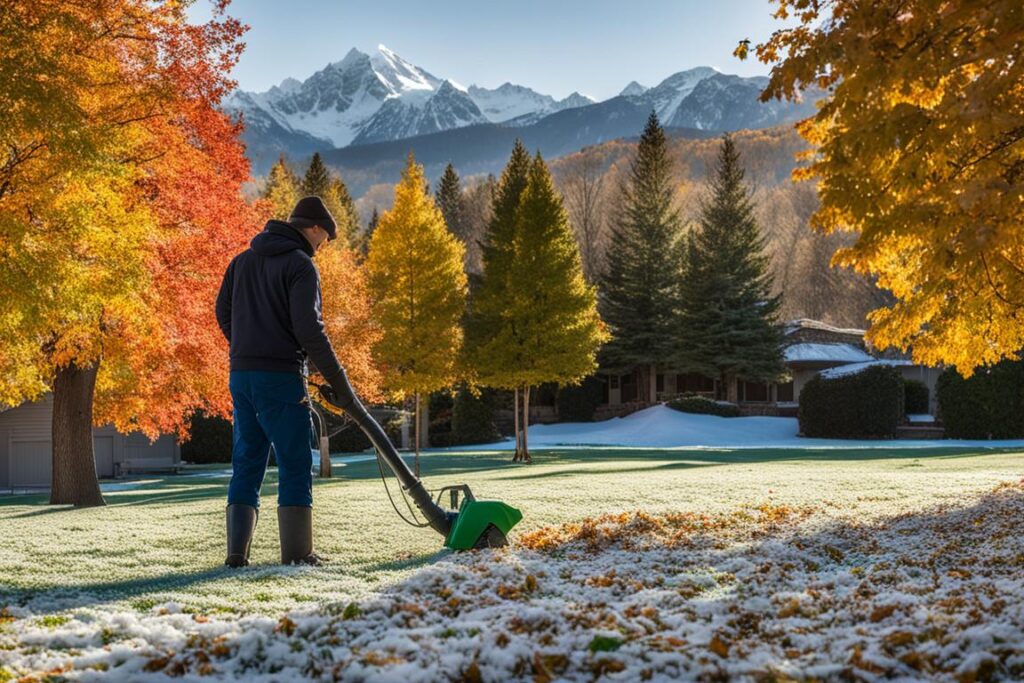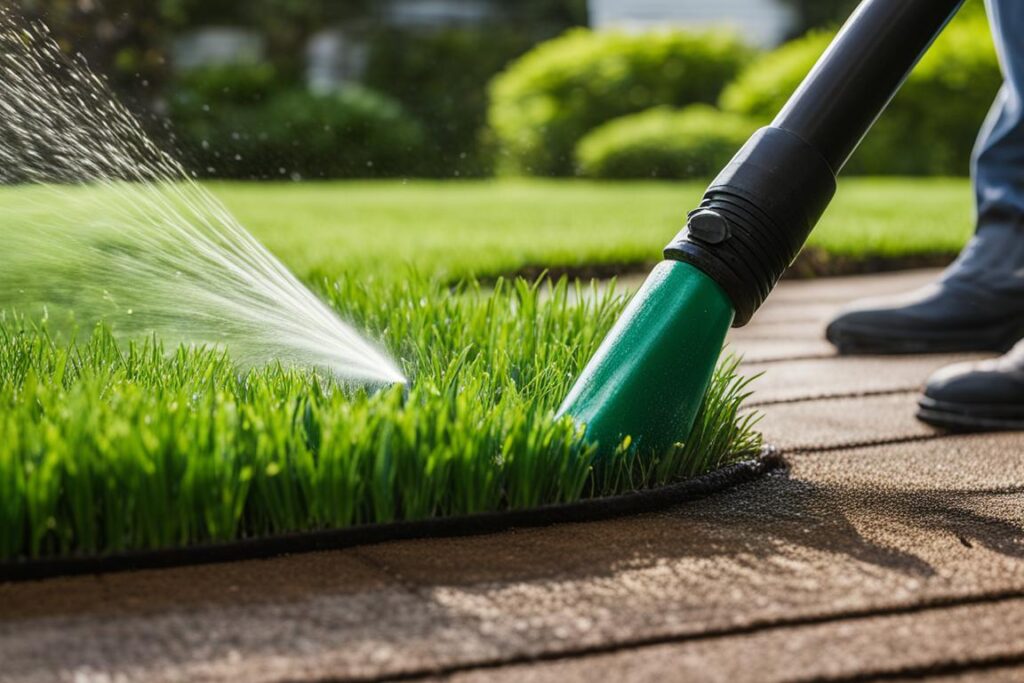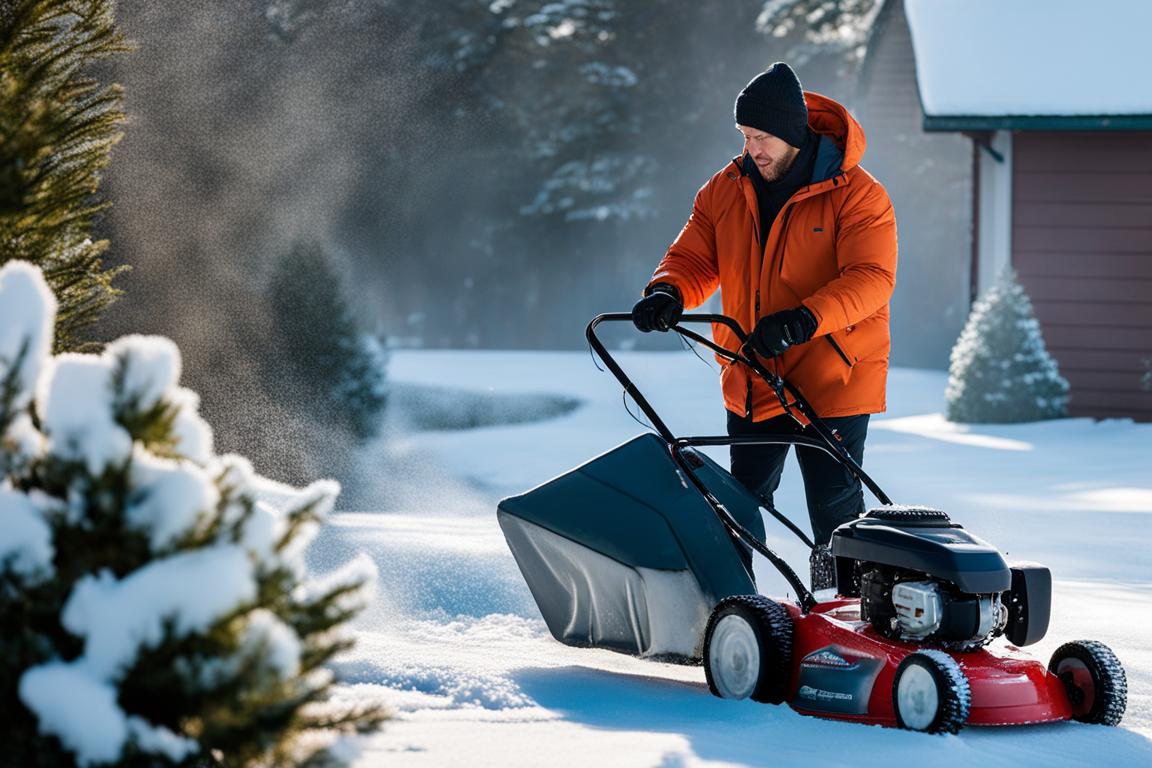When it comes to maintaining a healthy and vibrant lawn, knowing the best time to mow your grass is crucial. But what temperature is too cold for mowing? Can you still mow your lawn in cold weather? Let’s find out.
Grass goes into dormancy when it doesn’t receive enough heat, light, water, and nutrients. Extreme changes in temperature, such as heatwaves and freezing temperatures, can trigger dormancy. Generally, grass stops growing when temperatures drop below 50-55 degrees Fahrenheit or exceed 90 degrees Fahrenheit. Consistently warmer or cooler temperatures signal grass to become dormant.
Key Takeaways:
- Grass goes into dormancy in response to extreme changes in temperature.
- Grass generally stops growing when temperatures drop below 50-55 degrees Fahrenheit or exceed 90 degrees Fahrenheit.
- Consistently warmer or cooler temperatures signal grass to become dormant.
- Knowing when grass stops growing is essential for proper lawn care.
- Pay attention to temperature guidelines to ensure you’re mowing at the right time.
When Does Grass Stop Growing?
Grass growth patterns and dormancy are influenced by various factors, including temperature, water availability, and sunlight. Understanding when grass stops growing can help you plan your lawn care routine effectively.
In general, grass experiences its most rapid growth during late spring and early summer. This period is characterized by optimal conditions, such as adequate water, abundant sunlight, and warmer temperatures. During this time, grass blades grow longer and thicker, resulting in lush green lawns.
However, as the summer progresses and temperatures soar, grass growth slows down. Excessive heat can stress the grass, leading to reduced growth rates. In some cases, high temperatures can even trigger dormancy, causing the grass to temporarily halt its growth.
When late fall and winter arrive, grass enters a state of dormancy. Dormancy serves as a natural protective mechanism for grass to withstand extreme cold temperatures. During this period, the grass appears brown and does not actively grow. Instead, it conserves energy and resources to survive until more favorable conditions return.
It’s worth noting that extreme temperature changes can also induce dormancy in grass. Rapid fluctuations between hot and cold can signal the grass to enter a dormant state, even during periods that are typically conducive to growth. Therefore, it’s essential to consider temperature stability when determining the growth patterns and dormancy periods of your grass.
Understanding when grass stops growing enables you to adjust your lawn care practices accordingly. During active growth periods, regular mowing, watering, and fertilizing are necessary to maintain a healthy lawn. In contrast, when the grass is dormant, it requires minimal care and can withstand colder temperatures without damage.
To gain a better understanding of grass growth patterns, refer to the table below, which illustrates the key periods of growth and dormancy throughout the year.
| Season | Growth Pattern |
|---|---|
| Late spring and early summer | Rapid growth |
| Mid-summer | Reduced growth due to excessive heat |
| Late fall and winter | Dormancy |
By understanding these patterns, you can align your lawn care practices with the growth cycles of your grass for optimal results.

Key Takeaways:
- Grass grows fastest during late spring and early summer when temperatures are warmer.
- Excessive heat in the summer can slow down grass growth.
- Grass enters a dormant state in late fall and winter, conserving energy to withstand colder temperatures.
- Extreme temperature changes can trigger grass dormancy.
- Understanding grass growth patterns and dormancy helps plan effective lawn care routines.
How to Prepare Your Lawn for Colder Temperatures
Preparing your lawn for colder temperatures is essential to ensure its health and vitality throughout the winter months. By taking a few proactive steps, you can protect your grass from the harsh effects of frost and promote its recovery when spring arrives.
Before the first frost, it’s important to mow your lawn a few times to maintain an optimal grass height. Aim to keep the grass between 2 1/2 and 3 inches tall. Mowing at this height helps prevent the grass from matting down and promotes better air circulation, reducing the risk of fungal diseases.
Pro Tip: Mowing the grass shorter before winter may seem like a time-saver, but it can actually do more harm than good. Leaving the grass slightly longer provides insulation and protects the roots from freezing temperatures.
In addition to mowing, it’s recommended to fertilize your lawn before the first frost. Fertilizer provides essential nutrients that help the grass remain healthy during dormancy. Use a slow-release fertilizer with a high nitrogen content to support root growth and winter hardiness.
Pro Tip: Apply the fertilizer according to the manufacturer’s instructions and water your lawn thoroughly afterward to activate the nutrients and ensure proper absorption by the soil.
When temperatures drop and frost sets in, it’s important to avoid cutting frozen grass. Cutting frozen grass can cause stress and damage to the blades, leading to a weaker lawn when spring arrives. Wait for the grass to thaw before resuming your regular mowing routine.
Pro Tip: Keep an eye on the grass to determine when it noticeably stops growing. This can be a sign that it has entered dormancy and is no longer actively growing. At this point, it’s generally best to stop mowing until the grass wakes up from its dormant state in the spring.
To summarize, preparing your lawn for colder temperatures involves mowing at the right height, fertilizing before the first frost, and avoiding cutting frozen grass. By following these steps, you can ensure a healthier and more resilient lawn, ready to thrive when warmer weather returns.

| Steps to Prepare Your Lawn for Colder Temperatures: |
|---|
| Mow the lawn a few times to maintain a height of 2 1/2 to 3 inches. |
| Fertilize the lawn before the first frost with a slow-release, high-nitrogen fertilizer. |
| Avoid cutting frozen grass to prevent stress and damage. |
| Pay attention to when the grass noticeably stops growing to determine when to stop mowing until spring. |
How to Care for Grass When It Starts Growing
As the weather warms up, it’s important to give your growing grass the care it needs to thrive. Here are some tips to ensure healthy grass growth and prevent damage:
- Maintain watering schedules: Proper watering is crucial for promoting grass growth. Water deeply and infrequently to encourage deep root growth and prevent shallow rooting. Check your lawn’s specific watering requirements based on your grass type and local climate conditions.
- Avoid excessive fertilization: While fertilizing can stimulate grass growth, be cautious not to overdo it. Using excessive fertilizers can lead to rapid growth, making your grass more vulnerable to diseases and pest infestations. Follow recommended guidelines for fertilizing your specific grass type.
- Control weeds: Weeds can compete with grass for water, nutrients, and sunlight, hindering its growth. Regularly inspect and remove weeds manually or use appropriate herbicides to prevent weed invasion and promote a healthier lawn.
- Minimize grass traffic: Excessive foot traffic can compact the soil and damage the grass blades, impeding healthy growth. Limit heavy activities on the lawn and consider using designated walkways or pathways to minimize damage and encourage even growth.
It’s crucial to note that mowing plays a vital role in caring for growing grass. Let’s explore the optimal mowing temperature and techniques to stimulate grass growth while preventing damage.
Optimal Mowing Temperature
The ideal temperature for mowing grass is crucial to promote healthy growth and prevent stress and damage. As a general guideline, it’s best to avoid mowing when the temperature falls below 50 degrees Fahrenheit.
Mowing grass in colder temperatures can result in weakened grass blades and hinder recovery from potential damage. It’s essential to wait until the weather warms up before starting your mowing routine.

Grass Growth Stimulation and Prevention of Damage
When the temperature is suitable for mowing, follow these practices to stimulate thriving grass growth and prevent damage:
“Follow the one-third rule”
The one-third rule is a widely recommended technique for promoting healthy grass growth. When mowing, aim to cut no more than one-third of the grass’s current height. This allows sufficient leaf area for photosynthesis and helps maintain a robust root system, promoting healthy growth and minimizing stress on the grass.
By adhering to the one-third rule, you encourage the development of a denser and more resilient lawn that can better withstand environmental stressors.
| Benefits of the One-Third Rule | Drawbacks of Ignoring the One-Third Rule |
|---|---|
|
|
Remember to adjust the mowing height based on your grass type and follow the specific recommendations provided by lawn care experts or local agricultural extension offices.
Following these guidelines for caring for growing grass will help you maintain a lush and beautiful lawn that thrives throughout the growing season.
Conclusion
Proper winter lawn care is essential for maintaining a healthy and vibrant grass during the colder months. Understanding the optimal temperatures for mowing and caring for your lawn is key to its overall well-being. Grass enters a dormant state in response to extreme temperature fluctuations, protecting itself until more favorable conditions emerge. By following recommended mowing heights and paying attention to temperature guidelines, you can ensure that you are mowing at the right time.
Lawn preparation before winter is crucial for a successful season. Mowing your lawn a few times and maintaining a healthy grass height between 2 1/2 and 3 inches before the first frost will help provide a solid foundation. Additionally, fertilizing your lawn beforehand will provide the vital nutrients required for the winter period.
After winter, when the grass starts growing again, it’s crucial to care for it properly. Determine if the grass is dormant or dead and take the necessary steps to bring it out of dormancy. Follow good practices such as maintaining watering schedules, avoiding excessive fertilization, controlling weeds, and minimizing traffic on the grass to stimulate healthy growth and avoid damage.
In conclusion, maintaining a healthy and vibrant winter lawn requires proper care and attention. By understanding optimal mowing temperatures and implementing the necessary steps for lawn preparation and grass care, you can enjoy a beautiful lawn all year round. Remember, a healthy lawn not only adds aesthetic appeal to your property but also contributes to the overall environment and well-being of your outdoor space.
FAQ
What temperature is too cold to mow grass?
It is generally too cold to mow grass when temperatures drop below 50 degrees Fahrenheit. Mowing frozen grass should be avoided to prevent stress and damage.
Can I mow my grass in cold temperatures?
While it is possible to mow grass in cold temperatures, it is not recommended. Cold temperatures can negatively impact the health and growth of the grass. It’s best to wait for warmer weather to resume mowing.
When does grass stop growing?
Grass generally stops growing when temperatures drop below 50-55 degrees Fahrenheit or exceed 90 degrees Fahrenheit. Consistently cooler or warmer temperatures signal grass to enter dormancy and stop growing.
How should I prepare my lawn for colder temperatures?
Before the first frost, it is ideal to mow your lawn a few times and maintain a grass height between 2 1/2 and 3 inches. Fertilizing the lawn before the frost can provide extra nutrients for the winter. Avoid cutting frozen grass to prevent stress and damage.
How should I care for grass when it starts growing again?
Proper care of growing grass includes following temperature guidelines and the one-third rule when mowing. Avoid mowing when the temperature is below 50 degrees Fahrenheit. Follow the one-third rule, cutting no more than one-third of the grass’s current height to stimulate healthy growth and prevent damage.
What is the one-third rule for mowing grass?
The one-third rule means cutting no more than one-third of the grass’s current height at a time. This rule helps stimulate healthy growth and prevents damage to the grass.
How can I maintain a healthy lawn during winter?
To maintain a healthy lawn during winter, it is important to understand the optimal temperatures for mowing and caring for the grass. Proper lawn preparation before winter and care when grass starts growing again can help ensure a healthy and vibrant lawn.
Why is it important to follow recommended mowing heights?
Following recommended mowing heights ensures that the grass is at an optimal length for healthy growth. Cutting the grass too short can stress the grass and make it more susceptible to disease and weeds.
What should I do if my grass is dormant during winter?
When your grass is dormant during winter, it is important to avoid excessive traffic on the lawn and to continue controlling any weeds. Proper care and maintenance when spring arrives can help bring the lawn out of dormancy.
Can winter weather kill my grass?
While winter weather can be harsh on grass, it is usually the extreme temperature changes that trigger dormancy. With proper care and maintenance, including preparing the lawn before winter and caring for it when it starts growing again, the grass should survive and thrive.
